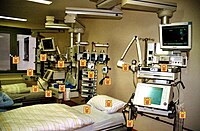
Photo from wikipedia
BackgroundVancomycin resistant enterococci (VRE) occur with enhanced frequency in hospitalised patients. This study elucidates the prevalence of VRE on admission among surgical intensive care unit (SICU) patients, whether these patients… Click to show full abstract
BackgroundVancomycin resistant enterococci (VRE) occur with enhanced frequency in hospitalised patients. This study elucidates the prevalence of VRE on admission among surgical intensive care unit (SICU) patients, whether these patients are at special risk for VRE acquisition and which risk factors support this process.MethodsPatients admitted to SICUs of the University Hospital Münster were examined during August–October 2017. VRE screening was performed within 48 h after admission and directly prior to discharge of patients. In parallel risk factors were recorded to estimate their effect on VRE acquisition during SICU stay.ResultsIn total, 374 patients (68% male) with a median age of 66 years were admitted to one of the SICUs during the investigation period. Of all, 336 patients (89.8%) were screened on admission and 268 (71.7%) on discharge. Nine patients were admitted with previously known VRE colonisation. Twelve (3.6%) further patients were VRE positive on admission. During ICU stay, eight (3.0%) additional patients turned out to be VRE colonised. Risk factors found to be significantly associated with VRE acquisition were median length of stay on the ICU (14 vs. 3 days; p = 0.01), long-term dialysis (12.5% vs. 2.0% of patients; p = 0.05), and antibiotic treatment with flucloxacillin (28.6% vs. 7.2% of patients; p = 0.01) or piperacillin/tazobactam (57.1% vs. 26.6% of patients; p = 0.01).ConclusionsSICU patients are not at special risk for VRE acquisition. Previous stay on a SICU should therefore not be considered as specific risk factor for VRE colonisation.
Journal Title: Antimicrobial Resistance and Infection Control
Year Published: 2018
Link to full text (if available)
Share on Social Media: Sign Up to like & get
recommendations!